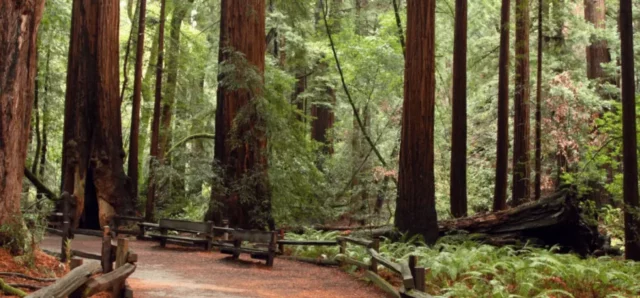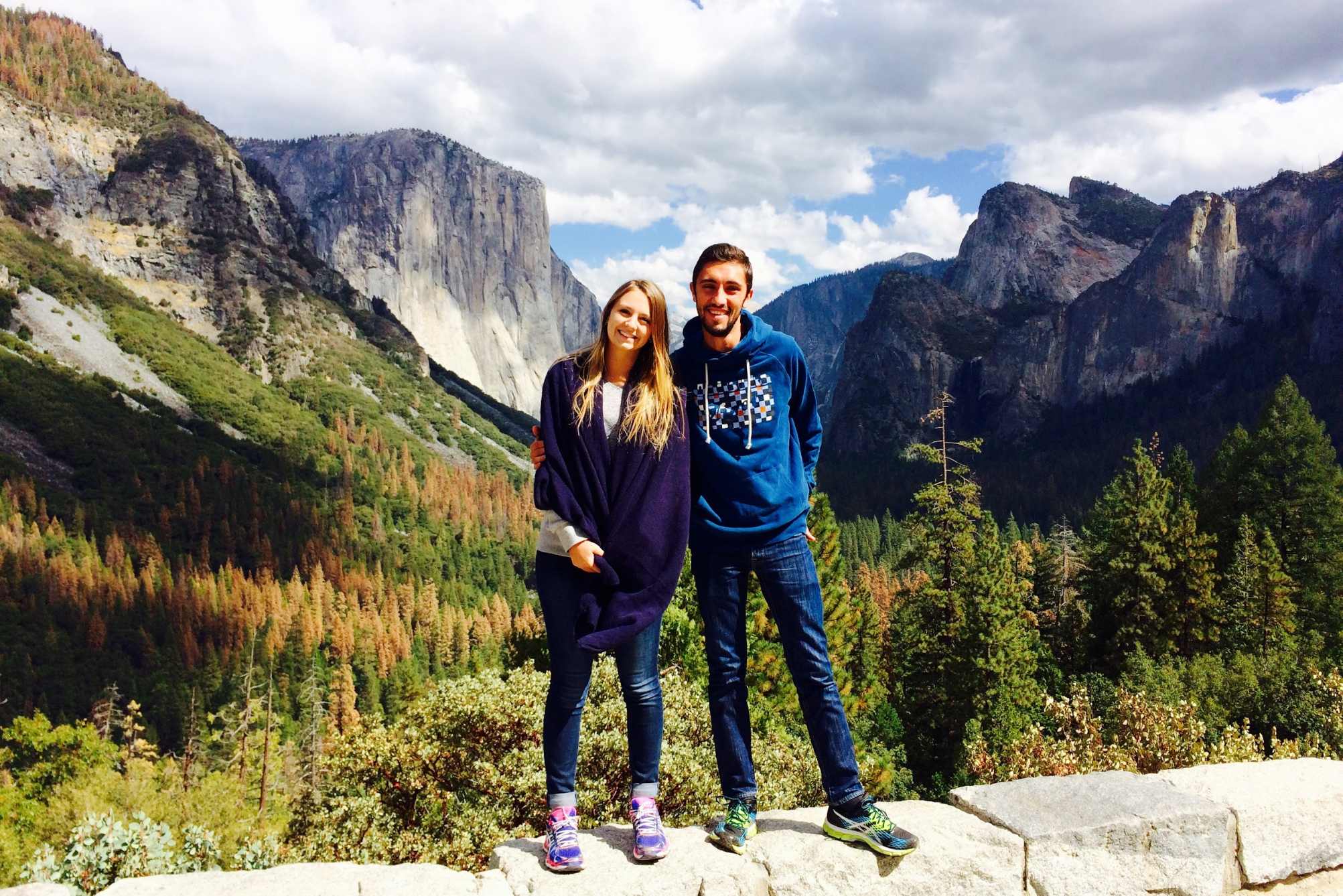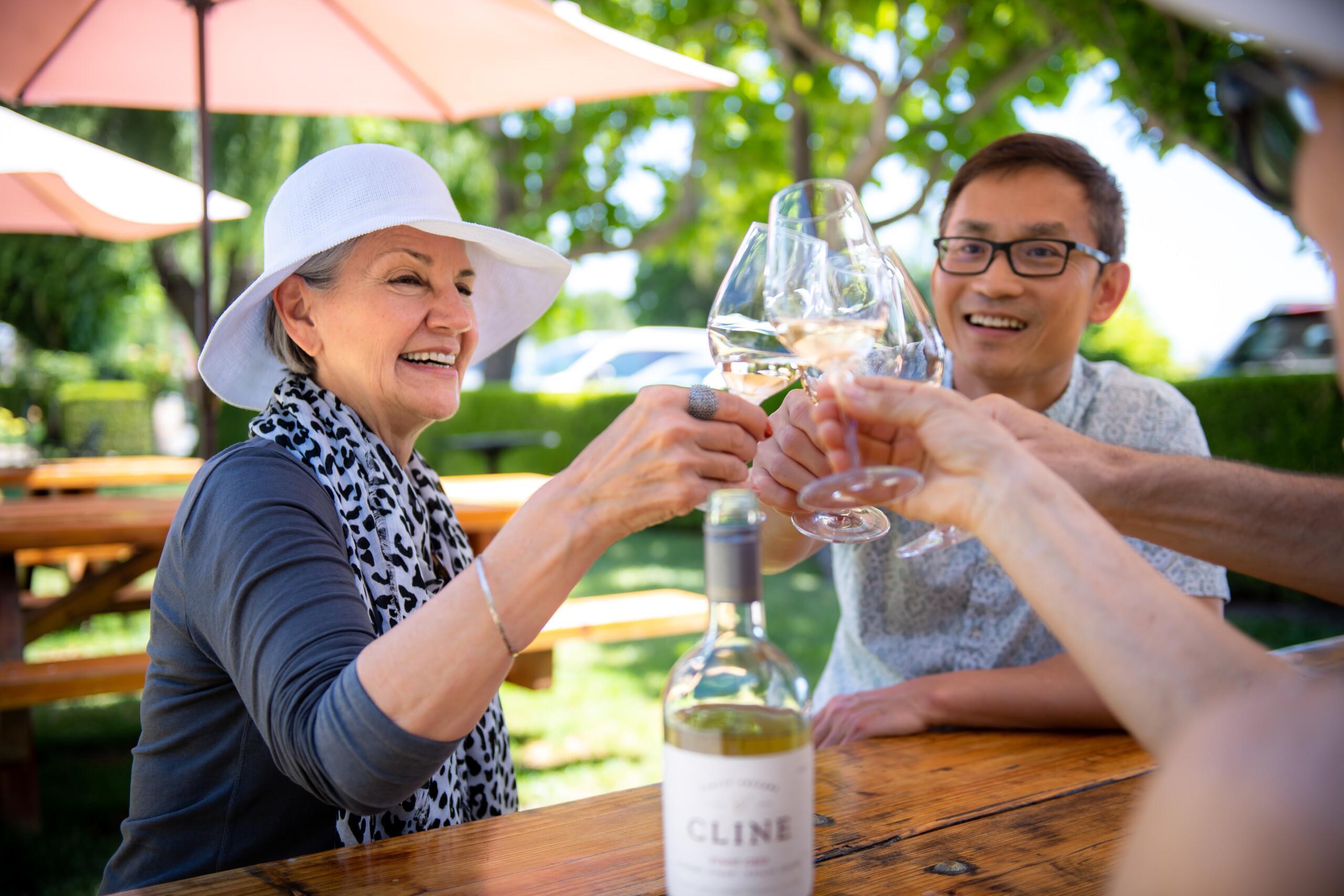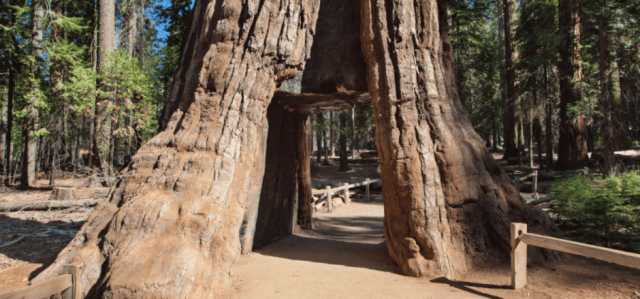Giant Sequoias vs. California Redwoods: What’s the Difference?

California is known for many things, and at the top of the list are its mighty trees: Giant Sequoias and California redwoods. But are Giant Sequoias and redwoods the same species? And which one is better to visit on a day trip from San Francisco? Let’s take a look at the key differences between these two species and redwoods and where you can see them in the Bay Area.
What Are California Redwoods?
The California redwood is relatively unique to the Golden State, although you’ll also find redwoods in some parts of Oregon. California redwoods include two of the three species of the Sequoia family commonly known as “redwood”.
The Coastal Redwood (Sequoia Sempervirens) grows along the coast, and can be found in several national parks near the Bay Area, including in Muir Woods right outside of San Francisco. This type of redwood is the tallest species of tree in the world, growing as high as 380 feet.
The Giant Sequoia (Sequoiadendron Giganteum) grows in the Sierra Nevada mountains. You’ll find several Giant Sequoia groves in Yosemite, as well as in nearby Sequoia and Kings Canyon National Park. These trees are the largest trees in the world by volume and can grow to be 3,000 years old.
The Dawn Redwood (Metasequoia glyptostroboides) is the outlier of the group. It diverged from the other two species around 150 years ago, and is native to China. It’s the smallest of the three species, and unusually for conifers, it’s a deciduous tree that sheds its needles every winter.

Yosemite and Giant Sequoias One Day Tour from San Francisco
The only 1-day Yosemite National Park tour from San Francisco to deliver more than you dreamed at Half Dome, El Capitan, Yosemite Falls, and on a hike to Giant Sequoias.

Exclusive Muir Woods, Napa & Sonoma Valley Wine Tour
The only wine country tour to combine three Napa & Sonoma Valley wineries with a morning excursion to San Francisco’s stunning Coast Redwood forest – Muir Woods.
Where Can You Find California Redwoods?
Coastal redwoods are indigenous to select areas along the California coast where they thrive in the mild coastal climate along a 750 km (470 mi) strip in isolated groves stretching from Redwood National and State Parks, 480 km (300 mi) north of San Francisco near the Oregon state line, to Santa Clara and Monterey Counties, 200 km (125 mi) south of San Francisco. They can also grow at higher elevations of up to 920 m (3,000 ft) on the western slopes of mountains near abundant and moisture-laden sea air.
Today, transplanted Coast Redwood can be found in other locations around the world, including in England, Australia, and even downtown San Francisco in the Transamerica Redwood Park. There are 50 coastal redwoods that were brought up from Santa Clara County in 1972 and transplanted at the eastern base of the Transamerica Pyramid.
Of course, these trees aren’t as large and impressive as the Giant Sequoia and California redwoods you can see in the wild. The giant redwood forest closest to San Francisco is Reinhardt Redwood Regional Park or Muir Woods National Monument, where the tallest coastal redwood has grown to 256 ft (78 m).
One of the most spectacular coastal redwoods, known as the “Lost Monarch”, has reached a height of 98 m (320 ft), while Hyperion is 116 m (380 ft.) Their precise locations have been kept secret to protect the delicate ecosystem around it from excessive foot traffic.
In environments like these, the upper crowns of dense coastal redwood grow so closely together their limbs will often merge with each other. This creates a canopy high above the forest floor where airborne debris can collect, decay, and even form a soil-like substance that has been reported to reach depths of up to a meter (3 ft), high above the earth.
In mountainous regions, coastal redwoods won’t reach the heights normally attained by those exposed to frequent heavy fogs, and are often crowded out by other conifers. Fog is the lifeblood of these trees because they draw moisture from their towering foliage that flows down to the roots.
How Long do California Redwoods Live?
Coastal redwoods live 500 to 600 years on average, although one coastal redwood is known to have survived for 2200 years. They reproduce in several ways depending on the particular stage of growth. Trees of the Cupressaceae family are monoecious (mon-ee-shus), a tree that has both seeds and pollen and reproduces asexually and dioecious (di-ee-shus), a tree that has only seeds or pollen and must reproduce through heterosexual fertilization.
Coastal redwoods have shallow roots that extend in a circular pattern up to 50 ft (15 m) in diameter around the tree’s base, also called a crown. New trees can sprout from these roots in the same circular pattern. This growth pattern is known as a “fairy circle,” and is similar to the way mushrooms grow. It’s why you’ll often see circular groups of trees growing around a parent tree.
This method of reproduction also occurs when a tree is damaged by wind or lightning. A hormone stimulates dormant buds to begin growing around a tree’s crown or base, low on the trunk, or from a stump. Even fallen trees can foster new growth. As the tree decays on the forest floor, new trees can sprout from dormant buds along the downed trunk. This is why several trees can appear to be growing in a straight line.
All coastal redwoods have cones, and after a decade of growth, thousands of seeds develop. However, only about 7% of the seeds will result in a young tree. In addition, the ground beneath a coastal redwood grove, thick with ferns and other undergrowth, is often unsuitable for sprouting seeds.
To protect itself, the coastal redwood is suffused with tannin, the source of its resistance to fire, insects, and decay. Tannin gives the wood and bark its red coloring, while the absence of resin makes it hard to burn. These properties outweigh its soft and brittle nature.
Of the remaining trees today, about 32,000 hectares (80,000 acres), or 4%, are protected thanks to the hard-won battles of activists in the 1980s. However, some old-growth coastal redwoods are still at risk in commercial forests.
Giant Sequoias of California

The Giant Sequoias of California are part of the redwood family, but have a different lifespan and history. In the 19th century, Native Americans who lived in the area knew the Giant Sequoia in Calaveras State Park as Toos-pung-ish or Hea-mi-withic. In 1852, a hunter named Augustus T. Dowd was tracking a grizzly bear when he came upon this grove of Giant Sequoia.
Dowd brought his skeptical neighbors back to the site. Amazed, they called it the Discovery Tree and built a road to the grove, where they worked 22 days to fell the tree. It was exhibited across the country in places like New York and California, while its stump was used as a dance floor and a bowling alley. Today, Dowd is credited with “discovering” the new species.
Around 60 to 70 groves of native Giant Sequoia can be found across the western slope of the Sierra Nevada range about 290 km (180 miles) east of San Francisco. They can only be found at altitudes between 1300-2000 m (4500-6500 ft) north of Kings River and 1700-2250 m (5500-7500 ft) south of Kings River, which flows from high in the Sierra through the southern portion of the Central Valley’s vast agricultural region.
Tuolumne Grove, Merced Grove, and Mariposa Grove are the most popular groves found in Yosemite National park. OnesSequoia of moderate size grows on the valley floor near Sentinel Bridge, after being transplanted long ago for some forgotten occasion. There are other groves in Kings Canyon National Park, Giant Sequoia National Monument, and Sequoia National Park in the Sequoia National Forest. Groves of Giant Sequoia can be found as far north as the Tahoe and as far south as the Sierra National Forests.
While coast redwoods are the tallest trees by height, giant Sequoia are the largest trees in the world measured by volume. They can reach heights of between 50-85 m (165-280 ft) and between 6-8 m (18-24 ft) in diameter. The world’s largest Giant Sequoia is the General Sherman in the Giant Forest Grove of Sequoia National Park, measuring 84 mt (275 ft) in height with a diameter of 12m (40 ft). The oldest Giant Sequoia is thought to exceed 3500 years.
Giant Sequoia reproduce by seed or by sprouting from a stump after an injury. Cones begin to appear after 12 years and they mature after 18-20 months. On average, a mature Giant Sequoia can bear 11,000 cones between 4-7 cm (2-3 in) long, each with an average of 230 seeds. That means they can shed up to 300,000-400,000 seeds a year!
More cones are found in the upper foliage than on lower branches, and they remain closed and green for up to 20 years. The cones may shrink during hot weather when some seeds are released, while fire and insect damage cause cones to dry, open up, and release the most seeds. Insects and squirrels play an important role in dispersing the seed.
To germinate, the seeds require full sunlight and nutrient-rich soil. Fire serves to clear vegetation that would otherwise crowd out new growth and provides nutrients to the soil. Changing conditions in the Giant Sequoia’s habitat are not as much of a threat to existing trees; it’s the lack of young Giant Sequoia that truly poses a threat to their future.
History of Giant Sequoias and California Redwoods
For much of California’s history, Giant Sequoias and California redwoods have been exploited more than they’ve been protected. They got their name in the late 1700s when Spaniard Don Gaspar de Portola volunteered to lead an overland expedition from the Mission San Fernando de Velicata in Baja California up the length of Alta California.
At first Portola was unable to find his destination, but continued north and became the first European to arrive by land at San Francisco Bay. His group of soldiers, settlers, and Catholic Franciscan Padres were camped near the present day city of Watsonville when Portola noticed some “very high trees of a red color.” They had never before seen trees like these so Portola named them “palo colorado,” or redwood. Portola Redwoods State Park still features one of the best redwood hikes near San Francisco.
Before the discovery of gold in 1848, there were more than 800,000 hectares (2 million acres) acres of coastal redwood in Northern California known to the indigenous coastal Miwok as cho-lay. Soon after the 1849 Gold Rush, sawmills were built in company towns like Forestville in Sonoma County, very close to the Armstrong Redwood Preserve in Guerneville.
Thousands of huge coastal redwood logs were dragged out of the woods or floated down flumes and rivers across rugged terrain to the choked mill ponds of sawmills in boom towns near the Pacific coast. Teamsters guided massive wagons drawn by teams of up to 12 oxen or draft horses, and hauled tens of thousands of board feet of cut green lumber to the rocky shores and cliffs above the Pacific. Here, elaborate systems of blocks, tackles, cables and thick rope carried the lumber out to boats anchored up to a hundred yards off shore for lack of beaches or proper docks. Stacked in the holds and lashed to the decks, the trees were carried south to the burgeoning Bay Area.
You can see one of these ships, a 19th-century lumber schooner called the C A Thayer, at the National Maritime Museum near Aquatic Park at Fisherman’s Wharf in San Francisco. By the end of the 19th century, almost 97% of the once ubiquitous coastal redwood had been logged for lumber, railroad ties, trestles, fence posts, and pipelines. Robert Louis Stevenson is said to have paneled his living room in Samoa with Coast Redwood in 1891.
Visiting the Giant Sequoia and California Redwoods
Thanks to the efforts of conservationists like John Muir, Ansel Adams, and President Theodore Roosevelt, many of the remaining sequoia and redwood groves are protected in state or national parks. Visitors can tread carefully among the giants in Muir Woods, Yosemite National Park, and a few other places in Northern California.
To see the coastal redwoods, book a tour to Muir Woods from San Francisco, where you can hike the Muir Woods Redwood Creek Trail while listening to narration in your native language.
To see the Giant Sequoias, book a tour to Yosemite National Park, with a stop at Tuolumne Grove and other top attractions in Yosemite Valley.
FAQs
Are California redwoods the same as sequoias?
Sequoias are a type of California redwood, and are in the same family as the coastal redwood. But they’re a different species with unique characteristics, and they grow in different parts of Northern California.
Are redwoods or sequoias better to visit?
Both redwoods and sequoias are worth visiting, but coastal redwoods are easier to get to, because they grow closer to major cities like San Francisco and are accessible year-round. Sequoias are found in more remote places like Yosemite National Park, and some roads and trails may not be accessible in winter. It depends on how much time you have. Both types of trees grow to incredible sizes, and seeing them up close is an impressive experience.
Where is the best place to see the sequoias in California?
The best place to see Giant Sequoias in California is in Mariposa Grove or Tuolumne Grove in Yosemite National Park. Other popular spots include Sequoia and Kings Canyon National Park.